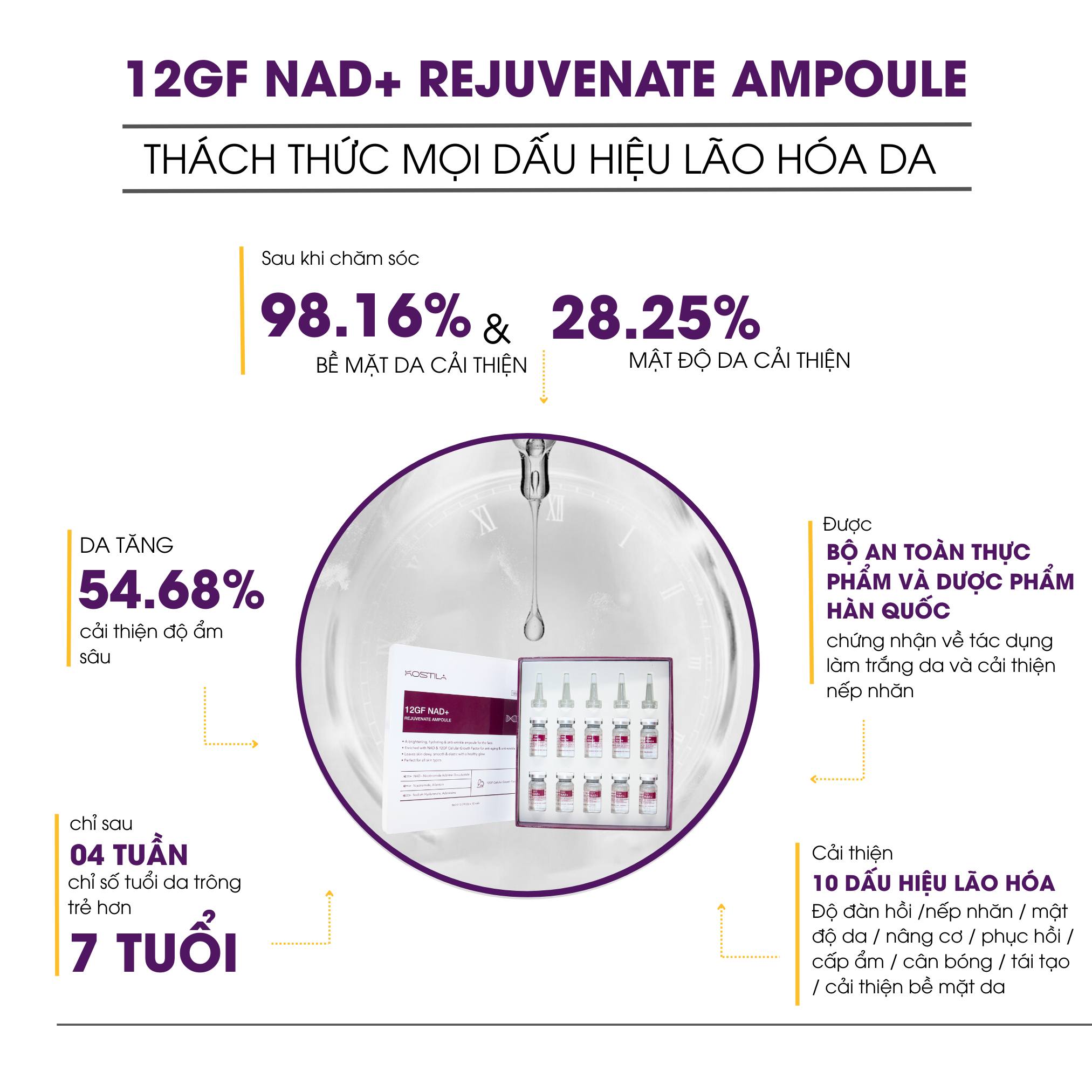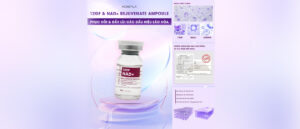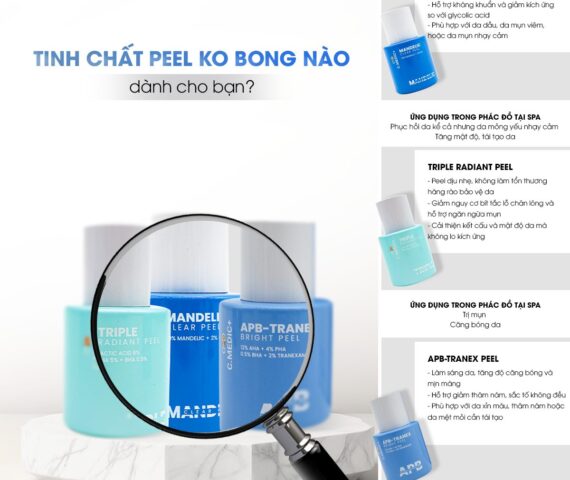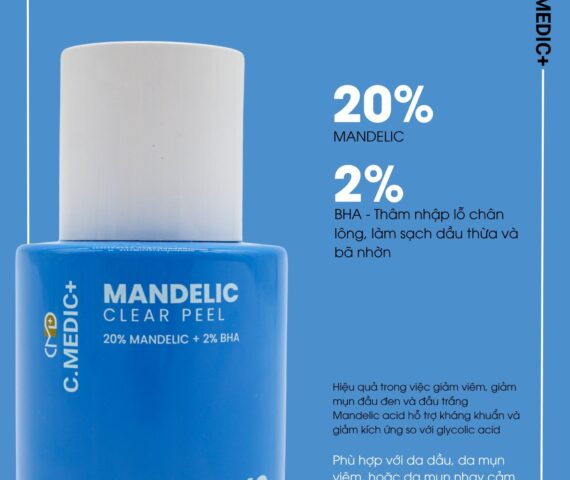Peel không bong – Xu hướng tất yếu của ngành làm đẹp an toàn Ngành làm đẹp đang bị siết chặt quản lý với...
Trong những năm gần đây, cuộc cách mạng chăm sóc da đã chứng kiến sự lên ngôi của các sản phẩm chứa yếu tố tăng trưởng (Growth Factors – GF), một nhóm protein tín hiệu sinh học có khả năng phục hồi và trẻ hóa da từ gốc. Dữ liệu nghiên cứu lâm sàng quy mô lớn, kết hợp với công nghệ tế bào gốc hiện đại, đang mở ra kỳ vọng mới cho những giải pháp chống lão hóa an toàn và hiệu quả bền vững.
Xuất phát từ nhu cầu tìm kiếm giải pháp trẻ hóa an toàn hơn so với retinoid, các nhà khoa học đã tập trung nghiên cứu tiềm năng của yếu tố tăng trưởng trong phục hồi cấu trúc và cải thiện sức khỏe tổng thể của làn da. Những bằng chứng lâm sàng được công bố gần đây cho thấy GF không chỉ giúp giảm nếp nhăn, cải thiện độ đàn hồi, mà còn củng cố hàng rào bảo vệ tự nhiên và thúc đẩy quá trình tái tạo tế bào. Đó là lý do 12GF NAD+ Rejuvenate Ampoule đánh dấu bước tiến vượt bậc nhờ sự phối hợp nhiều yếu tố tăng trưởng cùng các hoạt chất sinh học mạnh mẽ, giúp gia tăng đáng kể hiệu quả tái tạo và trẻ hóa trên nhiều chỉ số lão hóa quan trọng.
Nghiên cứu lâm sàng: 33 nghiên cứu, hơn 1.180 người tham gia
Một bài báo cáo khoa học được đăng trên Journal of Cosmetic Dermatology năm 2023 đã tổng hợp 33 nghiên cứu lâm sàng, bao gồm 9 thử nghiệm đối chứng ngẫu nhiên và 24 nghiên cứu tiền cứu, với sự tham gia của khoảng 1.180 người. Những người tham gia sử dụng các chế phẩm chứa GF bôi ngoài da hai lần mỗi ngày trong trung bình ba tháng.
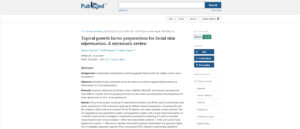
Kết quả cho thấy sự cải thiện đồng bộ trên nhiều khía cạnh: cấu trúc da được cải thiện rõ rệt với mức trung vị dưới 50% so với ban đầu, các nếp nhăn nhỏ giảm trung bình dưới 35%, trong khi diện mạo tổng thể gương mặt cải thiện khoảng 20%. Đáng chú ý, tỷ lệ tác dụng phụ rất thấp, chủ yếu chỉ là tình trạng đỏ nhẹ thoáng qua. Những kết quả này đã củng cố thêm niềm tin rằng GF không chỉ đơn thuần là xu hướng tiếp thị, mà là giải pháp chống lão hóa có cơ sở lâm sàng vững chắc.
Cơ chế hoạt động của yếu tố tăng trưởng khác biệt rõ rệt so với các hoạt chất tẩy da chết hóa học hay retinoid truyền thống. Khi bôi tại chỗ, các protein này hoạt động như tín hiệu sinh học, kích thích nguyên bào sợi tăng sinh và sản xuất collagen, elastin cùng acid hyaluronic – ba thành phần nền tảng duy trì độ săn chắc, đàn hồi và độ ẩm của da. Đồng thời, GF còn góp phần điều hòa viêm, sửa chữa DNA tổn thương và tái lập cấu trúc nền của lớp trung bì, giúp làn da được phục hồi toàn diện mà không gây bong tróc mạnh hay kích ứng kéo dài.
Nhờ tác động đồng thời lên nhiều lớp cấu trúc da, GF tạo ra cải thiện toàn diện và lâu dài, khác với các hoạt chất chỉ tác động bề mặt như AHA/BHA
Ví dụ:
EGF: tăng tốc độ hồi phục biểu bì
FGF: kích thích collagen type I và III
IGF: tăng sinh tế bào và tổng hợp protein nền
TGF-β: tái tạo mô và giảm viêm
12GF NAD+ Rejuvenate Ampoule – đỉnh cao công nghệ tế bào gốc
Sự phát triển nhanh chóng của công nghệ sinh học đã thúc đẩy các công thức ngày càng phức hợp và tinh khiết hơn. Một trong những minh chứng tiêu biểu là dòng sản phẩm tế bào gốc chứa 12 yếu tố tăng trưởng – 12GF NAD+ Rejuvenate Ampoule. Đây là sự kết hợp đồng thời của 12 loại GF chọn lọc, NAD+, Sodium DNA và collagen thủy phân, hướng đến cơ chế phục hồi đa tầng, tái tạo da và làm chậm quá trình lão hóa tế bào. Trong các đánh giá thực tế, liệu trình sử dụng sản phẩm này cho thấy chỉ sau bốn tuần, chỉ số tuổi da trông trẻ hơn 7 tuổi trong 4 tuần . Đồng thời, bề mặt da được ghi nhận cải thiện hơn 98%, mật độ da tăng trên 28%, nhờ đó giảm thiểu hiện tượng chảy xệ và nếp nhăn sâu. Cải thiện 10 dấu hiệu lão hóa mang lại hiệu quả chống lão hóa mạnh mẽ trên làn da đã thay đổi sẽ làm cho nó tỏa sáng như làn da ban đầu: Độ đàn hồi /nếp nhăn / mật độ da / nâng cơ / phục hồi / cấp ẩm / cân bóng / tái tạo / cải thiện bề mặt da. Sản phẩm này đã được bộ an toàn thực phẩm và dược phẩm hàn quốc chứng nhận về tác dụng làm trắng da và cải thiện nếp nhăn.
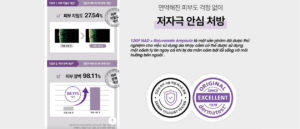
Điều đáng ghi nhận là khả năng dung nạp của công thức mới vượt trội so với nhiều hoạt chất chống lão hóa kinh điển. Trong các báo cáo theo dõi, đa số người dùng không gặp phản ứng kích ứng đáng kể, và sản phẩm có thể áp dụng ngay cả trên nền da nhạy cảm hoặc sau liệu trình xâm lấn nhẹ như laser, vi kim.
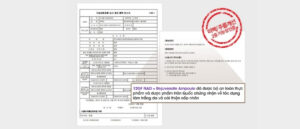
Sự kết hợp giữa bằng chứng nghiên cứu lâm sàng dài hạn và công nghệ sinh học tiên tiến đang tái định hình quan điểm về chống lão hóa tại chỗ. Nếu retinoid từng được xem là “tiêu chuẩn vàng” trong cải thiện nếp nhăn và kết cấu da, thì ngày nay, các chế phẩm chứa yếu tố tăng trưởng – đặc biệt là tổ hợp đa thành phần như 12GF NAD+ – đã chứng minh tiềm năng trở thành giải pháp toàn diện hơn, vừa đạt hiệu quả phục hồi sâu, vừa đảm bảo mức độ an toàn tối ưu.
Trong kỷ nguyên mà chăm sóc da không còn dừng lại ở che phủ tạm thời hay kích thích bong tróc bề mặt, GF và công nghệ tế bào gốc đang mở ra cánh cửa mới, nơi làn da có thể thực sự được tái lập nền tảng và phục hồi tuổi trẻ một cách khoa học, bền vững. Sự cộng hưởng giữa tri thức nghiên cứu và đổi mới công nghệ chính là động lực để tương lai của trẻ hóa da không còn chỉ là kỳ vọng, mà trở thành hiện thực có thể đo lường bằng số liệu và trải nghiệm lâm sàng.
—-
TÀI LIỆU THAM KHẢO
Ayer J, Ahmed A, Duncan-Parry E, et al. A photonumeric scale for the assessment of atrophic facial photodamage. Br J Dermatol. 2018;178(5):1190-1195.
Tobin DJ. Introduction to skin aging. J Tissue Viability. 2017;26(1):37-46.
Landau M, Anand CV, Besins T, et al. First consensus on primary prevention and early intervention in aesthetic medicine. J Drugs Dermatol. 2017;16(9):846-854.
Werner S, Grose R. Regulation of wound healing by growth factors and cytokines. Physiol Rev. 2003;83(3):835-870.
Mehta RC, Fitzpatrick RE. Endogenous growth factors as cosmeceuticals. Dermatol Ther. 2007;20(5):350-359.
Mehta RC, Naughton GK, Goldman MP. Cellular growth factors and exosomes. In: Draelos ZD, ed. Cosmetic Dermatology: Products and procedures. 3rd ed. John Wiley & Sons, Inc; 2022:401-407.
Fabi S, Sundaram H. The potential of topical and injectable growth factors and cytokines for skin rejuvenation. Facial Plast Surg. 2014;30(2):157-171.
Moher D, Liberati A, Tetzlaff J, Altman DG. Preferred reporting items for systematic reviews and meta-analyses: the PRISMA statement. Ann Intern Med. 2009;151(4):264-269.
Kellar RS, Hubka M, Rheins LA, Fisher G, Naughton GK. Hypoxic conditioned culture medium from fibroblasts grown under embryonic-like conditions supports healing following post-laser resurfacing. J Cosmet Dermatol. 2009;8(3):190-196.
Zimber MP, Mansbridge JN, Taylor M, et al. Human cell-conditioned media produced under embryonic-like conditions result in improved healing time after laser resurfacing. Aesthetic Plast Surg. 2012;36(2):431-437.
Phillips R, Ball C, Sackett D. Oxford Centre for Evidence-based Medicine – Levels of Evidence. Center for Evidence Based Medicine; 2009. https://www.cebm.net/2009/06/oxford-centre-evidence-based-medicine-level…
Higgins JP, Altman DG, Gøtzsche PC, et al. The Cochrane Collaboration’s tool for assessing risk of bias in randomised trials. BMJ. 2011;343:d5928.
Hersant B, Abbou R, SidAhmed-Mezi M, Meningaud JP. Assessment tools for facial rejuvenation treatment: a review. Aesthetic Plast Surg. 2016;40(4):556-565.
Chiu PC, Chan CC, Lin HM, Chiu HC. The clinical anti-aging effects of topical kinetin and niacinamide in Asians: a randomized, double-blind, placebo-controlled, split-face comparative trial. J Cosmet Dermatol. 2007;6(4):243-249.
Trookman NS, Rizer RL, Ford R, Ho E, Gotz V. Immediate and long-term clinical benefits of a topical treatment for facial lines and wrinkles. J Clin Aesthet Dermatol. 2009;2(3):38-43.
Sonti S, Makino ET, Garruto JA, Gruber JV, Rao S, Mehta RC. Efficacy of a novel treatment serum in the improvement of photodamaged skin. Int J Cosmet Sci. 2013;35(2):156-162.
Weiss RA, Weiss MA. Evaluation of a novel anti-aging topical formulation containing cycloastragenol, growth factors, peptides, and antioxidants. J Drugs Dermatol. 2014;13(9):1135-1139.
Lim VZ, Yong AA, Tan WPM, Zhao X, Vitale M, Goh CL. Efficacy and safety of a new cosmeceutical regimen based on the combination of snail secretion filtrate and snail egg extract to improve signs of skin aging. J Clin Aesthet Dermatol. 2020;13(3):31-36.
Farris P, Draelos ZD, de Oliveira F, Stehling L. Novel facial treatment regimen improves aging skin appearance. J Drugs Dermatol. 2021;20(3):274-278.
McKnight B, Seidel R, Moy R. Topical human epidermal growth factor in the treatment of senile purpura and the prevention of dermatoporosis. J Drugs Dermatol. 2015;14(10):1147-1150.
Sachdev M, Velugotla K, Revanker S, Somasekhar G. An open-label, single-center, safety and efficacy study of eyelash polygrowth factor serum. J Clin Aesthet Dermatol. 2020;13(2):61-66.
Lee HJ, Lee EG, Kang S, Sung JH, Chung HM, Kim DH. Efficacy of microneedling plus human stem cell conditioned medium for skin rejuvenation: a randomized, controlled, blinded split-face study. Ann Dermatol. 2014;26(5):584-591.
Kwon SB, An S, Kim MJ, et al. Phytosphingosine-1-phosphate and epidermal growth factor synergistically restore extracellular matrix in human dermal fibroblasts in vitro and in vivo. Int J Mol Med. 2017;39(3):741-748.
Merati M, Woods C, Reznik N, Parker L. An assessment of microneedling with topical growth factors for facial skin rejuvenation: a randomized controlled trial. J Clin Aesthet Dermatol. 2020;13(11):22-27.
Samizadeh S, Belhaouari L. Effectiveness of growth factor-induced therapy for skin rejuvenation: a case series. J Cosmet Dermatol. 2021;20(6):1867-1874.
Quinlan DJ, Ghanem AM, Hassan H. Topical growth factors and home-based microneedling for facial skin rejuvenation. J Cosmet Dermatol. 2022;21(8):3469-3478.
Prakoeswa CRS, Pratiwi FD, Herwanto N, et al. The effects of amniotic membrane stem cell-conditioned medium on photoaging. J Dermatolog Treat. 2019;30(5):478-482.
El-Domyati M, Moftah NH, Nasif GA, Ameen SW, Ibrahim MR, Ragaie MH. Facial rejuvenation using stem cell conditioned media combined with skin needling: a split-face comparative study. J Cosmet Dermatol. 2020;19(9):2404-2410.
Fitzpatrick RE, Rostan EF. Reversal of photodamage with topical growth factors: a pilot study. J Cosmet Laser Ther. 2003;5(1):25-34.
Mehta RC, Smith SR, Grove GL, et al. Reduction in facial photodamage by a topical growth factor product. J Drugs Dermatol. 2008;7(9):864-871.
Atkin DH, Trookman NS, Rizer RL, et al. Combination of physiologically balanced growth factors with antioxidants for reversal of facial photodamage. J Cosmet Laser Ther. 2010;12(1):14-20.
Kadoya K, Makino ET, Jiang LI, et al. Upregulation of extracellular matrix genes corroborates clinical efficacy of human fibroblast-derived growth factors in skin rejuvenation. J Drugs Dermatol. 2017;16(12):1190-1196.
Gold MH, Goldman MP, Biron J. Efficacy of novel skin cream containing mixture of human growth factors and cytokines for skin rejuvenation. J Drugs Dermatol. 2007;6(2):197-201.
Gold MH, Goldman MP, Biron J. Human growth factor and cytokine skin cream for facial skin rejuvenation as assessed by 3D in vivo optical skin imaging. J Drugs Dermatol. 2007;6(10):1018-1023.
Lupo ML, Cohen JL, Rendon MI. Novel eye cream containing a mixture of human growth factors and cytokines for periorbital skin rejuvenation. J Drugs Dermatol. 2007;6(7):725-729.
Hussain M, Phelps R, Goldberg DJ. Clinical, histologic, and ultrastructural changes after use of human growth factor and cytokine skin cream for the treatment of skin rejuvenation. J Cosmet Laser Ther. 2008;10(2):104-109.
Dreher F. A novel matrikine-like micro-protein complex (MPC) technology for topical skin rejuvenation. J Drugs Dermatol. 2016;15(4):457-464.
Bruce S, Karnik J, Dryer L, Burkholder D. Anti-aging proof of concept study: results and summary. J Drugs Dermatol. 2014;13(9):1074-1081.
Sundaram H, Gold M, Waldorf H, Lupo M, Nguyen VL, Karnik J. Pilot, multicenter, open-label evaluation of safety, tolerability and efficacy of a novel, topical multipotent growth factor formulation for the periorbital region. J Drugs Dermatol. 2015;14(12):1410-1417.
Draelos ZD, Karnik J, Naughton G. The anti-aging effects of low oxygen tension generated multipotent growth factor containing serum. J Drugs Dermatol. 2017;16(1):30-34.
Gold MH, Wilson A, Makino E, Mehta R. Improvements in skin quality parameters in postmenopausal participants after use of topical growth factor serum. J Cosmet Dermatol. 2023; 22(1):236-244.
Wu DC, Goldman MP. A prospective, randomized, double-blind, split-face clinical trial comparing the efficacy of two topical human growth factors for the rejuvenation of the aging face. J Clin Aesthet Dermatol. 2017;10(5):31-35.
Kim YJ, Seo DH, Lee SH, et al. Conditioned media from human umbilical cord blood-derived mesenchymal stem cells stimulate rejuvenation function in human skin. Biochem Biophys Rep. 2018;16:96-102.
Sachdev M, Chullikana A, Seetharam RN, Shilpakar R, Sapna R. A single arm, monocentric, prospective, open label study to evaluate anti-ageing efficacy of human growth factors and cytokines containing cosmetic skin serum in Indian female population. J Cosmet Dermatol Sci Appl. 2017;7:118-132.
Bhat S, Amirthalingam M, Ballambat SP, et al. Novel bioactive formulation derived from the conditioned medium of mesenchymal stromal cells reduces under-eye dark circles in human volunteers. J Cosmet Dermatol. 2022;21(2):814-826.
Alhaddad M, Boen M, Wu DC, Goldman MP. Red deer umbilical cord lining mesenchymal stem cell extract cream for rejuvenation of the face. J Drugs Dermatol. 2019;18(4):363-366.
Tribó-Boixareu MJ, Parrado-Romero C, Rais B, Reyes E, Vitale-Villarejo MA, González S. Clinical and histological efficacy of a secretion of the mollusk cryptomphalus aspersa in the treatment of cutaneous photoaging. Cosmet Dermatol. 2009;22(5):247-252.
Fabi SG, Cohen JL, Peterson JD, Kiripolsky MG, Goldman MP. The effects of filtrate of the secretion of the cryptomphalus aspersa on photoaged skin. J Drugs Dermatol. 2013;12(4):453-457.
Addor FAS. Topical effects of SCA® (Cryptomphalus aspersa secretion) associated with regenerative and antioxidant ingredients on aged skin: evaluation by confocal and clinical microscopy. Clin Cosmet Investig Dermatol. 2019;12:133-140.
McCullough JL, Weinstein GD. Clinical study of safety and efficacy of using topical kinetin 0.1% (Kinerase) to treat photodamaged skin. Cosmet Dermatol. 2002;15(9):29-32.
Katz BE, Bruck MC. Efficacy and tolerability of kinetin 0.1% cream for improving the signs of photoaging in facial and neck skin. Cosmet Dermatol. 2006;19(12):736-741.
McCall-Perez F, Stephens TJ, Herndon JH Jr. Efficacy and tolerability of a facial serum for fine lines, wrinkles, and photodamaged skin. J Clin Aesthet Dermatol. 2011;4(7):51-54.
Wanitphakdeedecha R, Meeprathom W, Manuskiatti W. Efficacy and safety of 0.1% kinetin cream in the treatment of photoaging skin. Indian J Dermatol Venereol Leprol. 2015;81(5):547.
Barone F, Bashey S, Woodin J. Clinical evidence of dermal and epidermal restructuring from a biologically active growth factor serum for skin rejuvenation. J Drugs Dermatol. 2019;18(3):290-295.
Rao J, Ehrlich M, Goldman MP. Facial skin rejuvenation with a novel topical compound containing transforming growth factor â1 and vitamin C. Cosmet Dermatol. 2004;17:705-713.
Ehrlich M, Rao J, Pabby A, Goldman MP. Improvement in the appearance of wrinkles with topical transforming growth factor β1 and L-ascorbic acid. Dermatol Surg. 2006;32(5):618-625.
Schouest JM, Luu TK, Moy RL. Improved texture and appearance of human facial skin after daily topical application of barley produced, synthetic, human-like epidermal growth factor (EGF) serum. J Drugs Dermatol. 2012;11(5):613-620.
Seidel R, Moy RL. Reduced appearance of under-eye bags with twice-daily application of epidermal growth factor (EGF) serum: a pilot study. J Drugs Dermatol. 2015;14(4):405-410.
Draelos ZD. The effect of a combination of recombinant EGF cosmetic serum and a crosslinked hyaluronic acid serum as compared to a fibroblast-conditioned media serum on the appearance of aging skin. J Drugs Dermatol. 2016;15(6):738-741.
Zeranska J, Pasikowska M, Szczepanik B, et al. A study of the activity and effectiveness of recombinant fibroblast growth factor (Q40P/S47I/H93G rFGF-1) in anti-aging treatment. Postepy Dermatol Alergol. 2016;33(1):28-36.
Lee DH, Oh IY, Koo KT, et al. Improvement in skin wrinkles using a preparation containing human growth factors and hyaluronic acid serum. J Cosmet Laser Ther. 2015;17(1):20-23.
Sadowski G, Sadowski J. Safety and efficacy of a novel antiaging skin care regimen containing neutraceuticals and growth factors on the facial skin of women: a 12-week open-label study. J Clin Aesthet Dermatol. 2020;13(6):24-34.
van Dongen JA, Langeveld M, van de Lande LS, Harmsen MC, Stevens HP, van der Lei B. The effects of facial lipografting on skin quality: a systematic review. Plast Reconstr Surg. 2019;144(5):784 e-797 e.
Aldag C, Nogueira Teixeira D, Leventhal PS. Skin rejuvenation using cosmetic products containing growth factors, cytokines, and matrikines: a review of the literature. Clin Cosmet Investig Dermatol. 2016;9:411-419.
Michalek IM, Lelen-Kaminska K, Caetano Dos Santos FL. Peptides stimulating synthesis of extracellular matrix used in anti-ageing cosmetics: are they clinically tested? A systematic review of the literature. Australas J Dermatol. 2019;60(4):e267-e271.
Miller-Kobisher B, Suárez-Vega DV, Velazco de Maldonado GJ. Epidermal growth factor in aesthetics and regenerative medicine: systematic review. J Cutan Aesthet Surg. 2021;14(2):137-146.
Lee YB, Lee KJ, Park HJ, Cho BK. Topical application of growth factors after carbon dioxide fractional laser therapy: a randomized controlled split-face study. J Cosmet Laser Ther. 2011;13(1):38-40.
Shin S, Shin JU, Lee Y, Kwon TG, Lee JH. The effects of a multigrowth factor-containing cream on recovery after laser treatment: a double-blinded, randomized, split-face controlled study. J Cosmet Dermatol. 2017;16(1):76-83.
Truchuelo MT, Vitale M. A cosmetic treatment based on the secretion of Cryptomphalus aspersa 40% improves the clinical results after the use of nonablative fractional laser in skin aging. J Cosmet Dermatol. 2020;19(3):622-628.
Hoss E, Kollipara R, Alhaddad M, Boen M, Goldman MP. Red deer umbilical cord-derived stem cell conditioned media combined with ablative resurfacing of the face. J Drugs Dermatol. 2020;19(11):1044-1048.
Pamela RD. Topical growth factors for the treatment of facial photoaging: a clinical experience of eight cases. J Clin Aesthet Dermatol. 2018;11(12):28-29.
Seo KY, Kim DH, Lee SE, Yoon MS, Lee HJ. Skin rejuvenation by microneedle fractional radiofrequency and a human stem cell conditioned medium in Asian skin: a randomized controlled investigator blinded split-face study. J Cosmet Laser Ther. 2013;15(1):25-33.
Kim YJ, Yoo SM, Park HH, et al. Exosomes derived from human umbilical cord blood mesenchymal stem cells stimulates rejuvenation of human skin. Biochem Biophys Res Commun. 2017;493(2):1102-1108.
Maisel-Campbell AL, Ismail A, Reynolds KA, et al. A systematic review of the safety and effectiveness of platelet-rich plasma (PRP) for skin aging. Arch Dermatol Res. 2020;312(5):301-315.
Humphrey S, Manson Brown S, Cross SJ, Mehta R. Defining skin quality: clinical relevance, terminology, and assessment. Dermatol Surg. 2021;47(7):974-981.
Ryu HS, Joo YH, Kim SO, Park KC, Youn SW. Influence of age and regional differences on skin elasticity as measured by the Cutometer. Skin Res Technol. 2008;14(3):354-358.
